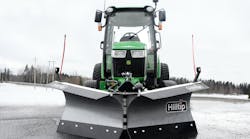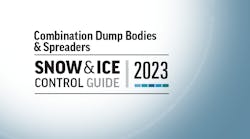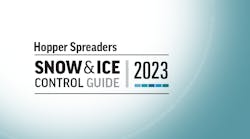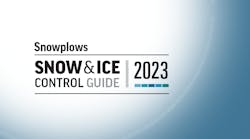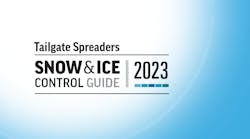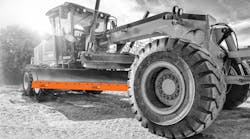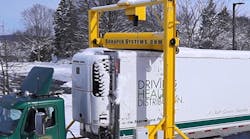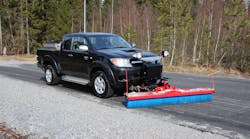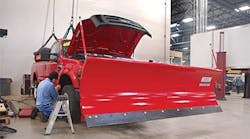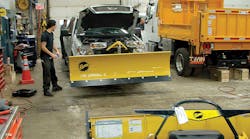The most significant changes in the manufacturers' guidelines for snowplow mounting for the 2013 model year come from Ford, which is reintroducing snowplow capabilities on the F-150 for the 6.2-liter engine only. (For 2014 guidelines, click here)
“We have some preliminary capabilities and we've been working with some of the snowplow manufacturers, because they're not going to have an option like we had in the past,” said Ford's Ken Tyburski, supervisor of product information for special vehicle engineering. “It's going to be on the base 4x4 vehicles, primarily in the super cab and crew cab models. We're going to provide some front weight requirements. It's more like a personal-use plow. The weight ratings are up to about 500 pounds, so it's not like a huge plow. On that size of vehicle, there are several plows of that category.
“It's not going to be an orderable option like we had in the past. But they're going to have to purchase a kit, or the snowplow guys will have to get the kit. On the outside air temperature sensor, we did a service release only for a pigtail that will get around so that the inside air temperature reading isn't affected when they have a plow in the front of the vehicle. It basically repositions the outside air temperature sensor.”
He said this is basically a carryover year for the Super Duty — they're just tweaking for loads based on vehicle weights that go up or down every year.
GM's Ken Joye said Regular Production Option (RPO) “VYU” Snowplow Prep returns on light- and heavy-duty 4WD models and the 2013 Chevrolet Silverado and GMC Sierra models will feature minor changes for the upcoming model year
- 1500/2500HD/3500HD Pickups and 3500HD Chassis Cabs: RPO NQF Electronic Shift (dash-controlled) 4WD Transfer Case is now available on work trucks (1WT).
- 1500 Light Duty: RPO “VYU” continues to be offered on Regular Cab 4WD Pickups.
- 2500HD/3500HD Heavy Duty: RPO “VYU” continues to be offered on regular, extended, and crew cab 4WD pickups. The new 6.0L CNG bi-fuel engine option (LC8) is available on 2500HD series extended cabs for the 2013 model year. The LML 6.6L Duramax diesel with 397 HP and 765 ft-lb torque will replace the LGH 6.6L Duramax on pickups with RPO “ZW9” (box delete).
- 3500HD Chassis Cab: RPO “VYU” continues to be offered on regular and crew cab 4WD trucks. The LML 6.6L Duramax diesel with 397 HP and 765 ft-lb torque will replace the LGH 6.6L Duramax on all chassis cabs for the 2013 model year.
Ram's Chris Borczon said that they now have electric power steering on the 1500 model.
“Even though we have not allowed plows on 1500 models, we want to stress that we prohibit it again because the loads the electric power steering will put on the truck, combined with the snowplow, just wouldn't work,” he said.
He said heavy-duty trucks (2500, 3500, 4500, 5500) are unchanged with respect to what is being launched this fall.
“There are some changes coming in January, but since the truck is not revealed yet, we aren't revealing any specifics,” he said.
The following list is for quick reference only. For a comprehensive list of the specific guidelines for each model, refer to the body builders book published by the truck manufacturer.
GM recommends that when a snowplow is mounted on a vehicle, only one passenger should accompany the driver. More than one passenger may exceed front gross axle weight ratings (GAWR).
Prior to installing a front-mounted snowplow, the following process should be followed and necessary information obtained:
- Establish vehicle curb weight.
- Establish chassis manufacturer's front and rear axle weight ratings.
- Chevrolet and GMC truck dealers can provide availability, specifications, gross vehicle weight rating (GVWR), and front and rear GAWR. For vehicles already built, this information can be found on the certification label installed on the driver's door/frame or provided on the cover of the incomplete vehicle document.
The following information should be obtained and provided by the manufacturers of snowplows and salt spreaders:
- Specifications, weights, and center of gravity data.
- Vehicle installation guidelines and instructions.
- Calculation of weight distribution for the front and rear axles.
The loaded vehicle with driver, passenger, aftermarket accessories, snowplows, spreader, and cargo must not exceed the GVWR, and front and rear GAWR.
The loaded vehicle with driver, passenger, aftermarket accessories, snowplows, spreader, and cargo must not exceed the GVWR, and front and rear GAWR. In addition, the completed curb weight vehicle, with all installed aftermarket accessories, snowplow, and spreader, and with 400 lbs for vehicles less than 10,000 lbs and 500 lbs for vehicles greater than 10,000 lbs distributed in the driver-passenger area of the vehicle, must have a center of gravity location that is located within the trapezoid formed by the coordinates A, B, C, D, H1 & H2, plus it must be to the rear of vertical line E and forward of vertical line F as defined in the allowable center of gravity charts. If the center of gravity location does not fall within the specified trapezoid, ballast weight may be required to shift the center of gravity location until it falls within the specified trapezoid.
The snowplow manufacturer and the installer of the aftermarket equipment should determine the amount of rear ballast required to ensure that the vehicle, with the attached snowplow and aftermarket equipment, complies with the Allowable Center of Gravity Trapezoid and the resulting front and rear weight distribution ratio as defined in the Allowable Center of Gravity Charts published in the GM manual.
The use of rear ballast weight may be required to prevent exceeding the GAWR of the front axle. The use of rear ballast weight may be required to ensure that the center of gravity location of the completed vehicle, with the attached snowplow and other installed equipment, complies with the Allowable Center of Gravity Trapezoid and the resulting front and rear weight distribution ratio, even though the actual front weight may be less than the GAWR of the front axle. In either case, the rear ballast weight should be securely attached in the cargo box or behind the rear axle of the vehicle in a manner that prevents it from moving during driving and stopping.
To help avoid personal injury, refer to Z-height setting procedure before adjusting torsion bars. If torsion bars are adjusted for aftermarket equipment, be sure to return them to specification when the equipment is removed. Otherwise, a front shock absorber may dislodge and damage a front brake line. This could result in an accident when minimum stopping distances are required.
K-Series snowplow best practices:
- OEM steering gear, suspension, and powertrain component mounting holes and associated OEM fasteners should not be used to attach snowplow-mounting equipment.
- A suggested allowance of 10 mm minimum clearance to stationary OEM components is highly recommended. Note these components have varying positional tolerances.
- A suggested allowance of 20 mm minimum clearance to OEM components subject to movement at full jounce is highly recommended. Note these components have varying positional tolerances.
- Snowplow and associated mounting equipment should not exceed front axle available payload rating of vehicle as optioned. Plow blade height, width, and mass should be in accordance with snowplow manufacturers recommended requirements for specific vehicle.
Ford Trucks
Snowplow package includes:
- Front spring/GAWR upgrade (refer to the weight ratings charts for specific spring/GAWR selection for each model).
- 157-amp, heavy-duty alternator (6.2L gasoline). Optional dual alternators, 357 amp (6.7L diesel).
Recommended equipment:
- All-terrain tires and roof clearance lights (optional with SRW pickup models, required with F-350 DRW and F-450).
Standard equipment:
- Front and rear stabilizer bar (rear standard on Chassis Cab and DRW pickup models).
- Roof clearance lights (standard on Chassis Cab and required on pickup models).
- Steering damper.
- Engine oil cooler, auxiliary automatic transmission oil cooler, and maximum-capacity engine coolant radiator are standard.
- All available axle ratios are acceptable.
- When snowplowing, operate automatic transmission with shift lever in overdrive position.
The vehicle must not be operated when overloaded. A vehicle is overloaded when the weight of the completed vehicle with aftermarket equipment installed, plus driver, passengers and cargo, exceeds either the FGAWR, RGAWR, or GVWR displayed on the Safety Compliance Certification Label.
The addition of ballast weight placed rearward of the rear axle may be required to prevent exceeding the FGAWR, and provide good vehicle braking and handling. The ballast should be attached securely to the vehicle with consideration for the normal driving dynamics of snowplowing and occupant safety in accidents.
For Ford completed vehicles of 10,000 lbs GVWR or less, the weight of permanently attached aftermarket equipment must not exceed the Total Accessory Reserve Capacity (TARC) displayed on the Safety Compliance Certification Label to maintain the compliance representation that came with the Ford built vehicle. Exceeding TARC may require re-certification. This applies only to the permanently attached equipment, such as the snowplow frame mounting hardware, and not to the removable portion of the snowplow blade assembly.
Front-end wheel alignment (toe) and headlight aim may require readjustment after installation of snowplow equipment. Failure to reset front wheel alignment may cause premature uneven tire wear. If required, reset to chassis manufacturer's specifications found in the Ford Shop Manual.
Installation of any inductive load devices, such as electric motors or electric clutches for clutch pumps, must not be connected to Ford vehicle wiring or fuse panels. Power for such devices should be taken directly from the battery or starter motor relay power terminal. Control of these devices should be achieved via relays. No direct current path should exist between Ford vehicle wiring and the installed load that is not filtered by the battery. These recommendations are intended to eliminate or minimize any induced reverse voltage into the Ford circuitry.
Ram Trucks
The loaded vehicle, including all aftermarket accessories, the snowplow system, passengers, and cargo, must not exceed the gross vehicle weight (GVW), front or rear gross axle weight (GAW) ratings specified on the Safety Compliance Certification label located in the driver's side door opening.
The empty truck with all permanently attached accessories and snowplow components must not exceed 62% of its total weight on the front axle to comply with FMVSS/CMVSR 105 Brake Certification. Permanently attached snowplow parts are those parts not easily removed when the blade is removed. The permanently attached parts are: subframe, hydraulic pump, hydraulic lift cylinder, lamps, wiring, snowplow controls, etc. If the front axle loading exceeds either 62% of the empty truck total weight, or the front GAWR, ballast compensating weight must be securely attached at the rear of the truck to bring front axle weight within weight specifications.
Notes for heavy-duty snowplows:
- At any time, the maximum number of occupants in the truck must not exceed two.
- Under any circumstances, vehicles should not exceed GVWR (Gross Vehicle Weight Rating), front or rear GAWRs (Gross Axle Weight Ratings).
- Snowplow prep packages are not available with Sport (AAG) package.
- Cargo capacity will be reduced by the addition of options.
- Ballast should be securely attached inside the box at 9” from the rear tailgate for pickups.
- The total weight of permanently attached hardware should not exceed 125 lb.
- Max snowplow weight should not exceed values for models shown in this section.
